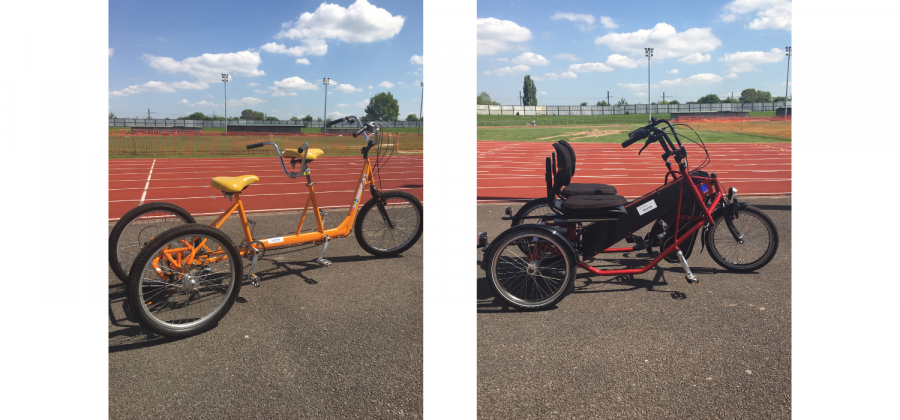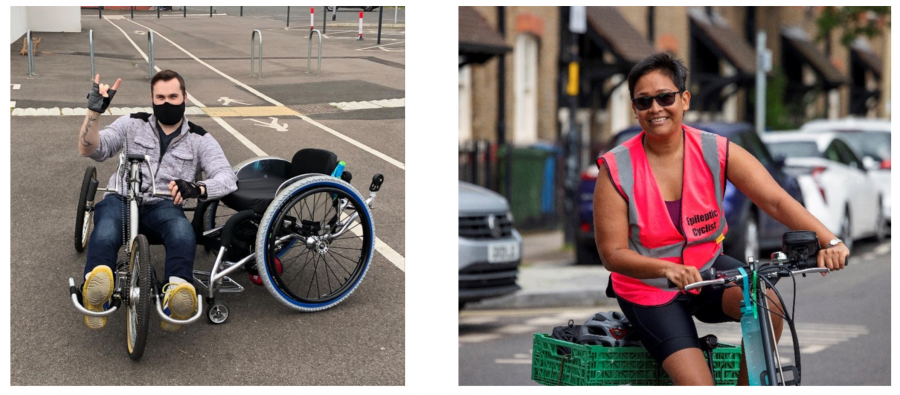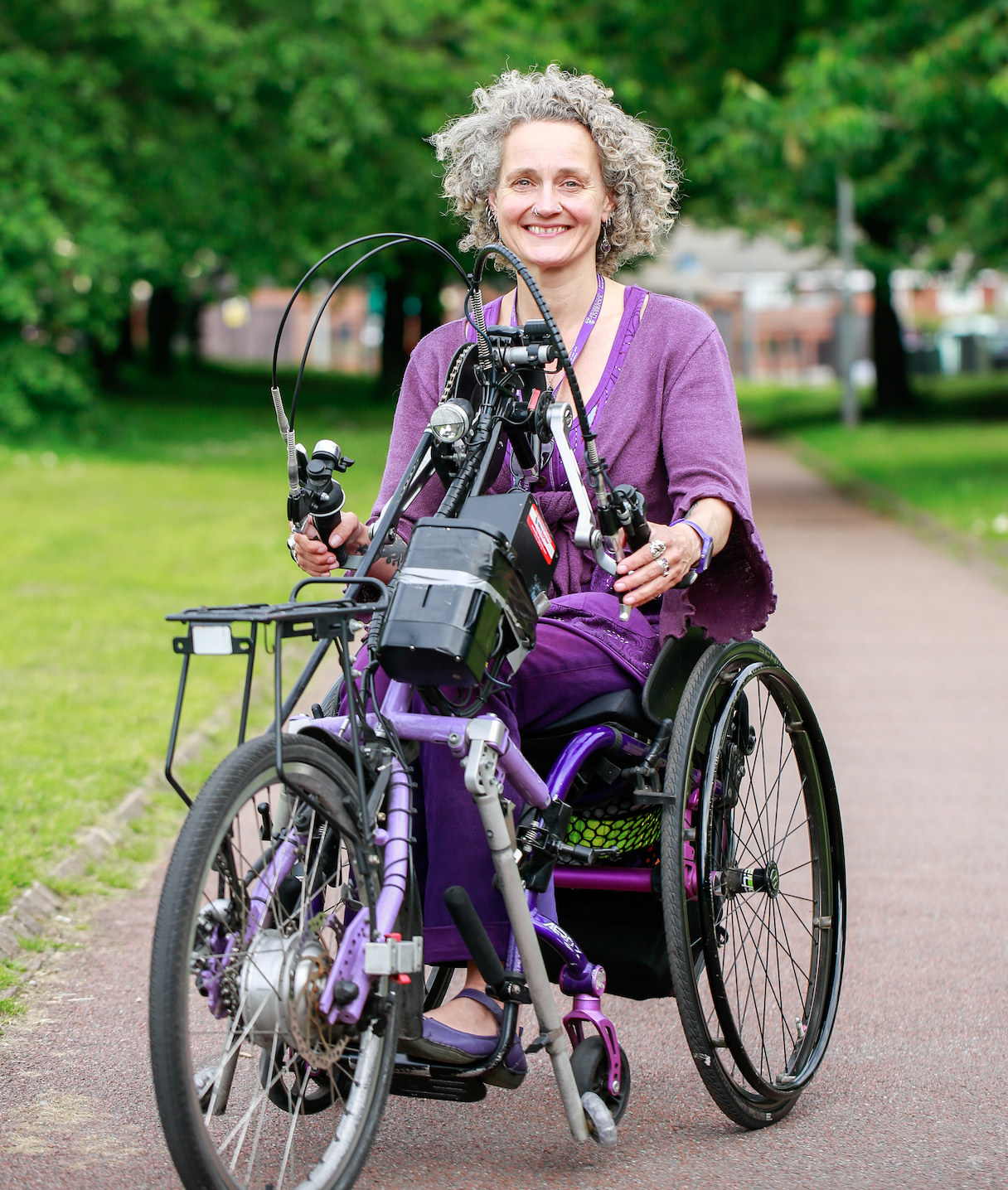9 min. read
Dr. Kay Inckle is the Campaigns and Policy Manager at Wheels for Wellbeing. Previously, Kay worked in the social/voluntary sector with psychiatric service-users. She holds a PhD and a post-doc exploring self-harm from a user-led, harm-reduction approach. In her academic career, Kay has explored how disability identity intersects with gender and sexuality, sport and exercise.
Could you tell me a little bit about your role at Wheels for Wellbeing, as well as the core tenets of the organisation?
Wheels for Wellbeing is a disabled people’s cycling organisation. We provide access to cycling for disabled people through three centres in London where people can go and use a whole range of different cycles such as side-by-side cycles, tandems, recumbents, handcycles or tricycles. People who may think that they can’t cycle, because all they can imagine is bicycles, have the opportunity to see and try out lots of other ways of cycling. The second part of the organisation, which is where my role sits, is the campaigning side.
Our provision of inclusive cycling opportunities sits within a broader ethos of mobility justice. We believe that cycling and active travel should be as easy, convenient, affordable and accessible for disabled people as it is for everybody else. We’re trying to challenge the barriers to cycling which include infrastructure, cost, attitudinal barriers and access to non-standard cycles. We’re also working at policy level with the government, local authorities, and other organisations to make sure that they understand that disabled people can and do cycle if barrier-free access to cycling is made possible.
Wheels for Wellbeing states that it works within the social model of disability. Could you briefly explain this?
The social model of disability challenges the idea that disability is just a medical problem or a medical complaint, or the notion that disabled people have something wrong with them and therefore can’t do anything. It flips that on its head and argues that actually what stops disabled people doing things is not the disability itself but the lack of access: the fact that most of society, both in terms of its social and its physical structures, is designed around a very limited ideal or type of body which is basically a young, white, able-bodied straight man. This design type excludes all kinds of other people as well, such as pregnant women, elderly people and so on.
The social model challenges those barriers and positions disability as a social identity in the same way that we view issues like ethnicity, gender, sexual orientation and age. Disability is just another of those human experiences, it is a natural part of human diversity, but it is excluded from full social participation. We need to recognise that there is huge diversity on the planet, and that if we start to think about universal accessible design, we create a much fairer world where everybody is equally invited to participate.
What are some of the main barriers for persons with disabilities to cycle? And conversely, when/if the right conditions are provided, what opportunities arise?
There are three main barriers. The first is infrastructure. In the UK, so much cycling infrastructure is designed around an able-bodied person on a two-wheeled bicycle, who can get off that bicycle, push it, lift it over a style, go through a “kissing gate”, lift it up and lock it in a raised cycle parking space. This means that even if your disability allows you to ride a standard two-wheeled bicycle, the infrastructure stops you being able to cycle because you can’t just get off or lift it or lock it when you’re supposed to.
If you ride a non-standard cycle, such as tricycle, a recumbent, a handcycle, cargocycle, or a tandem, the dimensions are so much bigger and most cycle infrastructure becomes difficult to navigate, there is not the turning space, it’s too narrow, all kinds of gates and access points exclude you as do many parking facilities. We are, however, making progress on this in the UK. The government now has official guidance whereby all cycle infrastructure has to be fully inclusive and designed around a very large cycle with a large turning circle
One of the other challenges is cost. Standard bicycles are available second hand quite cheaply and good quality new bikes are also available for not a huge amount of money. However, if you need something like a recumbent or a tricycle or a handcycle you’re looking at thousands of pounds. A handcycle, which attaches to a wheelchair, is often the same price as a second-hand car. This comes in the context of the disability employment gap and the disability pay gap which means that disabled people who already have less money than the wider population then face the additional barrier of cycles that cost multiple times more than a standard bike. There are also some other difficulties around ownership as well, such as storage. It’s a lot harder to find somewhere to store a recumbent or a cargo bike especially if you are on a low income and/or living in high density housing: you may be able to squeeze a standard bicycle in the hallway of a flat, but you’re not going to get a tricycle in there.
The third key barrier is the attitudinal one, which comes from society more broadly and particularly the kind of welfare culture that promotes the idea that being disabled equals being unable to do anything. Therefore, any sign of physical activity or ability is often construed as people being “fakers” or not really disabled. People can fear that if they’re seen as physically active, they’re going to lose the benefits that they depend on. Yet, if you use a handcycle that doesn’t mean you can stand up to change a light bulb, it just means that you can propel yourself around with your hands. These huge attitudinal barriers are baked in at quite a high level of some of the policies that really have a very powerful influence over disabled people’s lives.
Lastly, there is a worrying lack of knowledge about the range of cycles available or that cycling is possible for disabled people. I’ve spoken to disabled people who have been attending hospital physiotherapy where they’re put on static bicycling machines or static handcycle machines, but no one ever said this could be a form of mobility or exercise outdoors. I think that is almost the biggest tragedy, because disabled people have the least access to mobility, autonomy and independence and cycling can be an answer to that. If you can get hold of a cycle and are able to cycle, then cycling itself is relatively low cost, it’s door to door, it’s completely independent, it’s sustainable and you have your means of mobility and transport completely under your control.

Wheels for Wellbeing has worked to capture stories of empowerment through cycling – how do you see these narratives as a useful advocacy tool?
Those stories on the website are so important because people can look and see someone like themselves who also thought would never be able to cycle take that journey and talk about their own experiences and the massive impact cycling has had on their lives.
Disabled people have some of the worst physical and mental health outcomes among the broader population and a lot of that is because of forced immobility. They also face transport dependence, such as having to pre-book community transport, rely on taxis, or have to navigate situations where a bus ramp is broken. When you cycle, you instantly get your freedom and autonomy back, and the opportunity for social connections. Cycling is a much more sociable, connecting experience than being sealed up in a car. It can be really transformative for people. These narratives show people with a range of disabilities and from a range of backgrounds and ages that they too can benefit from cycling. The stories also help to raise awareness among non-disabled people.
Wheels for Wellbeing frequently collects information about the needs and experiences of disabled cyclists, or disabled people who wheel and cycle. Why is this data collection important?
It gives us really useful data about the barriers that people are facing, for example, how much cost or infrastructure impacts people’s ability to cycle as much as they would like to. It also allows us to track the situation over time. These surveys are carried out every year to eighteen months so we can track whether different policies are having an impact.
Our survey this year is going to have questions about COVID-19, the impact of lockdown and the emergence of low traffic networks and pop-up cycle infrastructure, a lot of which has not been great in terms of accessibility. The pandemic has, like everything else, impacted disabled people worse. 60% of COVID deaths in England are disabled people.
During the lockdown period, our organisation alongside others began to think about what we could do to support disabled people when we couldn’t run our sessions. Wheels for Wellbeing started piloting a hire scheme where we allowed people to hire a cycle that they wouldn’t be able to purchase themselves for a medium-term loan period. It has been really interesting, because it’s tied in with a move towards shared cycles for the population more broadly. It allowed us to run a parallel to the shared bicycles schemes and how see how it could work for people that require a non-standard cycle.

Are policymakers, planners or other stakeholders responsive to the recommendations you have put forward to make cycling more accessible?
The inclusive cycling design guide that we produce has resulted in significant interest and uptake of many of the key recommendations put forward, such as cycle lanes being wide enough to accommodate a non-standard cycle. The government guidance in the UK now has what they call the standard design cycle and it gives the minimum length, width, and turning circle that everything has to be designed for, and it’s really big and would accommodate a huge range of different cycles.
I think often there has been a sort of false binary between cyclists and disabled people. Often in discussions about public space, there’s a very strong assumption that cyclists are all young, able-bodied men, and disabled people never do any active travel or never cycle. When cycling infrastructure is not accessible, able-bodied cyclists don’t see disabled cyclists and, if you’re a disabled person cycling on a standard bike, you become invisible as a disabled person, so you’re effectively erased from people’s consciousness. This perpetuates the problem. We need much greater visibility of disabled cyclists, but this is only possible when cycling infrastructure and other barriers like cost are addressed.
What would a truly inclusive cycling future look like?
There are a combination of factors that would make this a reality. Firstly, cycling infrastructure that is 100% accessible. We also need a whole range of hire and loan options for people. Not everybody is going to be in the position to own their own cycle, but just as we are starting to see the rollout of standard bicycle share systems for pickup or hire, there should be some kind of equivalent where disabled people can pick up a tricycle or a handcycle or a recumbent and use it for a short period. Developing subsidy or grant schemes and a second-hand market for the whole range of non-standard cycles is essential to bring down their cost.
Better links with public transport is another key factor. First and last mile options need to work for non-standard cycles, and public transport needs to accommodate space for these types of cycles. Finally, we need a cultural and attitudinal shift. It should be as desirable and encouraged to see disabled people moving around on all kinds of cycles as it is for everyone else, we need a normalisation of this kind of mobility for everyone.

